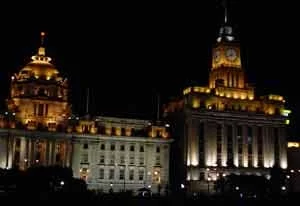Life goes on during Labour Day
May 7, 2004
ON THE road from Kunming to Dali, in southwestern China's Yunnan Province, Running Dog is enveloped in dust. The windows of our cab remain open, and the broken road – a result of unfavourable geological conditions and shoddy, rushed workmanship – lasts something like three hours. The mountainous rock is brittle and chalky, and the roadside is reinforced by concrete latticework, much of which has already shattered. Landslides are inevitable.
Bare-backed quarrymen, baked brown by the sun, cough and hawk under the onslaught, but still find the energy to dig, and dump sacks onto trucks, and hack away at the huge boulders that have been carved out of the nearby mountains. Coal trucks and wagons overloaded with gravel burst through the white mist. A patina of dust covers the fields and the trees on the roadsides.
During the Labour Day holiday, labourers at some of China's best known tourist spots are working as hard as ever, cracking rocks, lugging sacks of gravel, and laying paths along the mountains. Meanwhile, layabouts like Running Dog are wandering around, taking advantage of the salubrious, sylvan setting to get all misty-eyed about the nature of economic development, and the sacrifices it always entails. Along these roads, with the fields almost destroyed and the newly-planted trees wilting under a miasma of dust, workers are carving out the raw materials necessary to build the waves of new houses, office blocks and roads in the nearby cities.
Reaching Dali, a quaint and surreal little tourist trap - decked out in ethnic bric-a-brac and lined with toytown shops and cafes - the scenes continue, if one is in the mood to notice them. China, of course, is at the stage when one can see, at close hand, the pain and hard labour required to construct the sort of things most Westerners take for granted. Taking a cable car up to the Cangshan Mountain, one sees the old labourers, burnt to a crisp by the sun, inching slowly up the mountain pass with large concrete steps strapped to their backs. To make life more convenient for the tourists, smooth stone paths are being laid along the slopes and plateaux, and each rock has to be carried up, one by one.
Travelling around like this makes you realize what an enormous undertaking it is to develop an economy almost from scratch. Those new roads carved out of the soft and brittle rock, breaking and subsiding under the pressure of coaches and coal trucks; those long clouds of dust spraying over the local crops and clogging the lungs of nearby farmers and their children; those quarries eaten out of the mountain to feed the construction in the cities en route.. It is colossal, and terrifying, and Yunnan Province's ecology is bound to suffer.
It seemed ironic, of course, that the crowds of Lonely Planet types, most of whom have never done a day's work in their lives, are here in Dali to celebrate Labour Day. They are here, mostly, to look for what is sometimes described as The Real China, but the city of Dali is not quite what they are looking for. There are bars lined with student paraphernalia, including posters of Che Guevara and John Lennon, shelves of battered paperbacks, as well as the sickly-sweet stink of marijuana. Here, too, the image of Mao Zedong remains at some distance from the reality of his leadership. Mao kitsch - the T-shirts, the mugs, the plates and posters - is seen through the garish lens of jejune left-wing radicalism and also via Andy Warhol. Mao is packaged into a commodity, just another image to compete with the "working class heroes" of Lennon, Che, Bob Marley and Ginsberg.
Meanwhile, just near the old city's southern gate, we note the army base, and the corny Deng Xiaoping slogans about economic development, and the massive statue of some revolutionary hero with the sign underneath forbidding anyone to take photographs. The soldiers scowl and wave us away. We return to our oasis, our guest house, and our banana pancakes, and eavesdrop on our fellow travellers.
Doing so, we came to a number of conclusions. First of all, it seems that one is not a real traveller unless one has slummed it on a 48-hour hard-seat train, or trekked across the borders of several southeast Asian nations on a yak or a coal truck. The second is that travelling is an arduous and usually lonely business, and when you finally bump into strangers, it is necessary to begin trumpet-blowing. One way to compete with the others is in the ability to recite the relevant sections of Lonely Planet without referring to the book itself. If you really want to show off, however, it seems that you need to make wild, and wildly inaccurate generalizations about China and the Chinese people. One youthful Englishman was telling the rest that the use of Chinese characters means that the Chinese people use the right side of their brain more. Others said that the language actually produces a more circumscribed and submissive society.
The best way remains the descriptions of your travelling experiences, of course. Your conversations should be scattered with references to obscure fishing villages in Laos, or to the two-day hike you took, accompanied by a friendly Burmese peasant.
Running Dog does not want to be too harsh. While we travel nowhere without our luxury helicopter these days, we remember our train journeys of old, perched on our own luggage while two dozen migrant workers from Lanzhou spat sesame seed casings in our faces. We remember being vomitted on by queasy old timers on crumbling tour boats. And we do sympathize with the traveller's desire to find something real.
The "Real China" is a concept usually expressed in the negative. Shanghai, for example – a city where all the women behave like the most supercillious of air-hostesses, and where most of the men resemble hairdressers - is not the Real China. The Lonely Planet traveller trails – now occupied by the hordes of pedlars, the con-artists, the banana pancake stalls – aren't either. How about the cabbage patches that line the high-speed road from Dali to Lijiang, or the coolies on the mountainside, or the large blue coal trucks overtaking our car on a bend? How about at the Tianjing Pavillion on the other side of Erhai Lake, close to Dali, where a large pagoda was constructed in 1996 and kicked about a bit to make it seem more authentically antique? What, indeed, is authenticity? Is it in the gulags of Gansu or the bridges of Beijing?
In truth, Running Dog doesn't believe in the Real China concept. MacDonalds and Starbucks are now as Chinese as Communism, Shanghai's Bund and the Monkey King. Running Dog doesn't believe in the idea of "foreign elements", the sort of "impurities" in the national lifeblood that lead inexorably to movements like the Cultural Revolution and the Taliban. Even while closed off to the outside world, China was still interacting with the West, and with its neighbours, in all kinds of different ways.
This will continue, and despite the pontifications of our fellow travellers, we wonder how much anyone can really know about China. All kinds of foreigners produce all kinds of theories to explain the vastness of China's territory, and the variety of its peoples. Worst still, Chinese habits or errors are sometimes reduced to little more than a consequence of the evils of the government. Wandering around some of the markets in Kunming and Dali, one sees what one sees everywhere, from the bazaars of Baghdad to the prairies of Mongolia – the ordinary activities of communities trying to function, and the chaos of individuals trying somehow to get ahead in a changing, challenging world. The changes and challenges in China have been more perilous than most.





